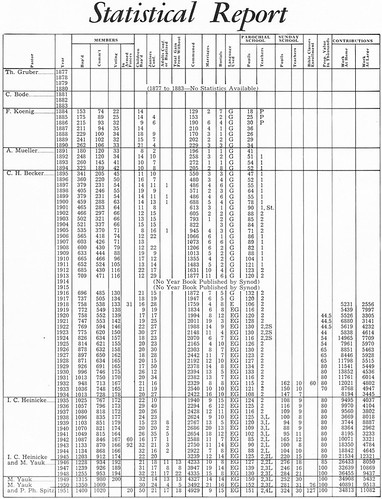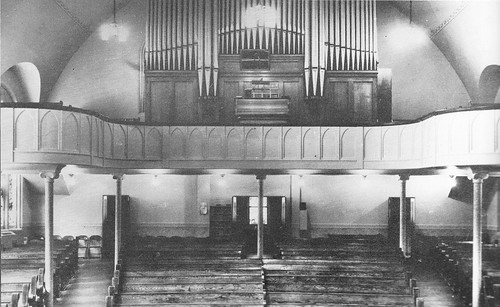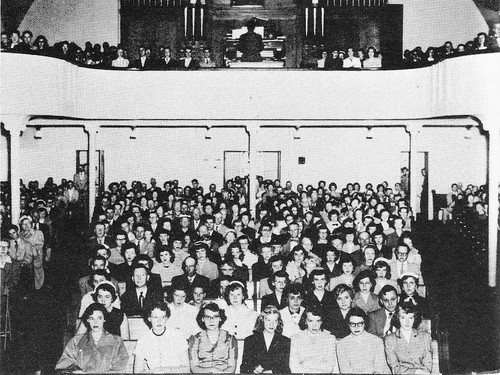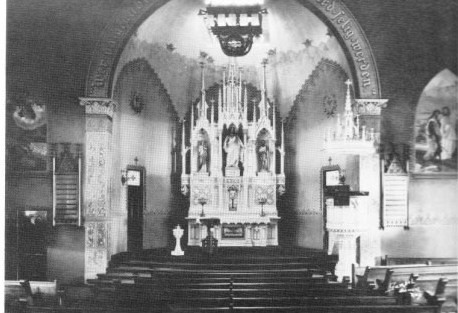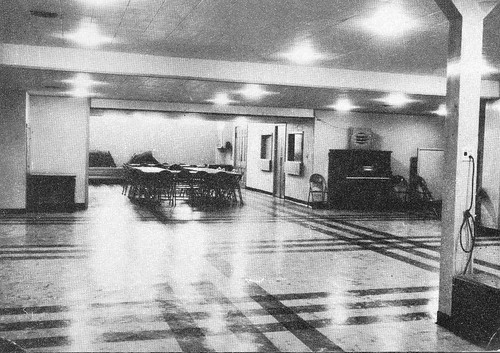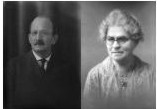Below, after some introductory remarks, is the third group of excerpts of Clara Alvina Koenig's manuscript An Afterglow of Yesterday. The manuscript was described in this earlier blog article.
The first excerpts, about J. George Weller's mother, was in this blog article.
The second excerpts, about the Weller family's move from Louisiana to Indiana, was in this blog article.
J. George Weller's parents -- Johann George Weller and Katerina Regina (Meyer) Lehnberg -- were born in Germany. They met in New Orleans, Louisiana, and eventually married there in 1854.
Two sons survived to adulthood. The older was Johann George (J. George, born in 1860), who eventually became a Lutheran pastor and then the Concordia president. The younger was Heinrich Herman (born in 1862), who eventually became a merchant.
The family moved from Louisiana to Indiana in about 1866. In 1873, when J. George Weller was 13 years old, he entered a preparatory school at Fort Wayne, Indiana, to begin his education to become a Lutheran pastor.
In 1882, J. George graduated from the Concordia Seminary in St. Louis, Missouri, married Louise Katharina Clara Eirich in New Minden, Illinois, and then moved to Marysville, Nebraska, where he began serving as a Lutheran pastor at Zion Evangelical Lutheran Church. He remained there until 1894, when he moved to Seward to become the first teacher at the new seminary there.
Marysville, Nebraska, which was located along Lincoln Creek, has been incorporated into the town of Staplehurst, which was about three miles east. Staplehurst is about seven miles northwest of Seward, Nebraska.
Another website provides the following information about the church.
Zion Evangelical Lutheran Church was founded in 1870. The congregation shared its first pastor, the Rev. Theodore Gruber, with the Immanuel Lutheran Church of Middle Creek. In 1873, Zion was received into membership in the Missouri Synod joining the Western District. The following year the Rev. Jacob Seidel became the first resident pastor, and a church and parsonage were built. A school was added in 1884.
Since many of Zion's members came from near Staplehurst, a sister congregation, Immanuel Lutheran Church, was organized there in 1888. Although Zion had two other sister congregations, Immanuel of Gresham and Immanuel of Rising City, Zion continued to grow in Marysville.
When the Marysville mill burned down in 1915, the town began to decline. However, Zion maintained its membership and erected its present church building that same year. In 1966, Zion and Immanuel of Staplehurst merged forming Our Redeemer Lutheran Church of Staplehurst, which meets in the old Immanuel church building.
The manuscript excerpts in this blog article describe the migration of German Lutherans from the area of Fort Wayne, Indiana, to the area of Marysville, Nebraska. These excerpts revolve around a family that was formed by the marriage of Friedrich Scheumann and Sophia Mailand near Fort Wayne, Indiana, in 1853.
Sophia Mailand's sister-in-law Wilhelmina Mailand (widow of Sophia's brother William Mailand) lived to the age of 96 and eventually became acquainted with Clara Alvina Koenig, the manuscript's author. Koenig acknowledges Wilhelmina as a major source of information for the manuscript.
The following passages are excerpted from the manuscript:
The Scheumann family, consisting of the father, two grown sons and a daughter, the stepmother and several younger children, came to Adams County, Indiana, in about 1844. Friedrich, the oldest son, was nearly seventeen years of age when the family left Germany. ....
Dietrich Brandt with his father and an older brother migrated to the United States in 1845 (Frau Brandt had died in 1841.) Conrad Brandt and his two sons settled in Adams County, Indiana.
Friedrich Hartmann (a cousin to Friedrich Scheumann) and his wife, Caroline Aroline, left Prussia in 1845. An infant son, little Fred, braved the perilous ocean voyage with them. The Hartmanns found a home in Allen County, Indiana. Adams and Allen are neighboring counties in Indiana.
The Scheumanns, the Brandts and the Hartmanns soon became well acquainted. The Conrad Grotz and the Louis Leibrock families lived in the same vicinity and knew the other families well.
On December 1, 1853, Friedrich Scheumannn and Sophia Mailand stood before Pastor W. Kolb as he pronounced them husband and wife. The newly-weds moved to a sixty-acre clearing in Allen County, about fifteen miles from Fort Wayne.
Various pieces of furniture were added to the household effects, thanks to Friedrich’s ability in carpentry and to Sophia’s knack of painting. Friedrich even built a cutter, which Sophia painted and decorated. Christian Mailand often took Louisa Mailand riding in that cutter. (Christian was a half-brother to Friedrich and Louisa, or “Leeza”, was Sophia’s youngest sister.) In due time, Christian and Louisa were married. They lived just across the road from Friedrich and Sophia, but in Adams County, because the road divided the two counties.
On September 21, 1854, a son gladdened the hearts of the Friedrich Scheumanns: the baby was named Friedrich, in honor of its father and its uncle. Within six weeks joy was turned to sorrow when the child died. Another son was born May 14, 1856. He was named Wilhelm, in honor of his Grandfather Mailand.
William Mailand spent about twenty-five years of his life in this country. After her bereavement, Wilhelmina Mailand stayed with Friedrich and Sophia most of the time.
Reports of “the land of promise” [Nebraska] had reached Indiana, and so we find several Indiana families on their way to Nebraska in 1868.
With a covered wagon and a team of oxen, Dietrich Brandt and his family joined the tide that swept westward. Arriving at Nebraska City, Dietrich left his wife and three children there while he, together with Conrad Grotz, Conrad Brandt and Louis Leibrock, went further into the interior of the state. After locating his claim in the precinct of Seward county, Mr. Brandt returned to bring his family to their new home. For three weeks they were obliged to live in their covered wagon until the dug-out could be completed. Every evening, they could hear the sound of the deer and the antelope, mingled with the howling of wolves and the yelling of Indians.
In the fall of the year, Ferdinand Mailand and his family packed their household effects into a covered wagon, and said “good-bye” to their relatives and friends in Indiana. Mother, father and the younger children rode in the wagon while Henry, the oldest son, followed on a horse. It was the boy’s duty to watch the cows as they plodded along behind the wagon or grazed by the wayside. At the end of a long weary journey, the Ferdinand Mailand family settled on a suitable homestead in Seward County, Nebraska.
In the fall of 1868, the two Scheumann brothers went to look at prairie land in Nebraska. After Friedrich selected a homestead they returned to Indiana.
On the 29th of November, another son was born to Sophie and Friedrich. He was named Dietrich Friedrich Heinrich Christian. The last name was used, in preference to the others.
The following spring (in March) Grandmother Mailand went to live with her youngest daughter, Mrs. Christian Scheumann. The Friedrich Scheumann family and the Hockmeyers bade friends and relatives farewell and boarded the train which was to carry them across Illinois and Iowa. There was no bridge across the Missouri River at that place. Passengers, mail, covered wagons, livestock, and household goods were taken from the train and transported, by ferryboat, to Nebraska City, on the opposite bank of the river.
There the Scheumanns and the Hockmeyers were welcomed by the Hartmann boys who had come for supplies. They asked Bill Scheumann to ride with them. Since there was safety in numbers, the three wagons proceeded in file. They followed “the Fort Kearney and Nebraska City Road” -- not a paved highway, but a trail winding across the prairie to Fort Kearney. At night, the younger children and their mothers slept in the wagons. Bill Hartmann and Bill Scheumann fought over possession of the spring seat of their wagon. They were both thirteen years of age and each one felt he was entitled to sleep in the seat. One of the men acted as sentinel while the others slept near the wagons. Their trusty guns, a faithful dog, and, above all, fervent family prayers kept them safe from Indians and wild animals.
After having been on the hot and dusty road nearly a week, our pioneers came to the village of Lincoln. This frontier town, which then had a population of thirty-two, was named in honor of the beloved President who gave his life to preserve the Union.
The following day Hockmeyers and Scheumanns stopped to visit the Dietrich Brandt and the Conrad Grotz families, who lived along Middle Creek. After a short visit, the journey was continued toward Lincoln Creek, where the Ferdinand Mailand, the Friedrich Hartmann and the Bill Meyer families lived. All these were happy to see their relatives from Indiana. Since Mrs. Hockemeyer was a sister to Bill Meyer, the Hockemeyers stayed with Sophia and Bill for a while.
The Scheumanns proceeded to the homestead that Friedrich had selected the preceding fall. The 160-acre tract of land was located about four miles south of Ulysses, along the Big Blue River. After arriving at their destination, Sophie Scheumann felt safe in ripping the hem of her petticoat to get the money she had tucked there when the family left Indiana. It was all safe -- $2,700.00 in paper money.
The original homesteaders, Mr. and Mrs. Pitt, did not leave immediately after selling their land to the Scheumanns. They lived together in the one-room dug-out (about 16 by 20 feet in size) which had only one door and two windows. The Pitts moved their few furnishings, a bed, a stove, and a small table, toward one end of the room and the Scheumanns occupied the other. Two full-sized beds and a trundle-bed (a low bed that was pushed under the other beds during the day) furnished sleeping quarters for the nine Scheumanns. A large wooden packing box that had served as a trunk on the westward trip, was used to enlarge the small table so it would accommodate ten people -- the baby did not yet sit at the table.
After about six weeks, Mr. and Mrs. Pitt bought a new homestead several miles down the Blue River, near the place where five houses and a small store marked the beginning of Seward.
In June 1868 Beaty and Davis opened a dry goods and grocery store in Seward; another general store was opened in 1869 by Herman Diers. Money was scarce, so farm products and wood were bartered for things that could not be produced at home.
Having been accustomed to regular Sunday services and daily instructions while in Indiana, the pioneers made provisions for these in their new homes. Each family had its daily devotion including a Scripture reading, songs, and prayers; on Sundays, the largest cabins or dugouts served as houses of worship for the neighborhood. The people came afoot, in wagons, or on horseback, in “Sunday best” or in calico, during the heat of summer or the cold of winter. Many of the early Sunday meetings were held in Friedrich Hartmann's dugout or in his log shed, and at Scheumann's -- first in the dugout, then in the new cabin. In their respective homes, “Hartmann’s Vater” (as he was often called) and Friedrich Scheumann led the singing and read the sermons out of an old “Predigsbuch” which had been brought from the old country.
On one of his missionary trips into the state, Rev. Kuegele of Omaha heard of these meetings and made it a point to contact the scattered families. Baptisms and weddings were postponed, for weeks or even months, until the pastor could return to this part of the country. On one occasion several children were to be baptized. The families met the pastor at the home of Bill and Sophia Meyer, who lived in a dugout near Father Hartmann. After services, preparations were made for serving the guests before they started homeward. Very unexpectedly, a piece of sod fell on the table. The women looked up to see a hoof and part of a shaggy leg protruding from the ceiling. The men folks rushed through the door to find the intruder: one of the oxen had stepped through the roof and the weight of the animal threatened to break all beams and supports. As quickly as possible, the ox was removed and the table was cleaned and set once more.
Sometimes Cupid attended the Sunday meetings. As the various families were returning to their wagons, Herr Yauch asked Friedrich Scheumann’s aid. Yauch had just recently come from Germany and wondered whether courting was done in the same way among his new friends as he had seen it in his native land. The young man was very bashful and wanted “Scheumann’s Vater” to introduce him to the Kirshner girl. The contrast was striking: Yauch was dressed in his best clothes -- a white shirt, white vest and trousers, a black Prince Albert coat and a tall silk hat -- while the girl looked as though she were Maud Muller in her gingham gown and with bare feet. But their story did not end with “it might have been” because the couple was married after only one month of courtship. Bill Meyer sold them a table, a bed, and several smaller pieces of furniture, for only four dollars. A storm door, laid over several barrels served the Meyers as table until another one could be constructed.
One day during their first year in Nebraska, Friedrich Scheumann and his son Bill were driving to Lincoln. They watched the storm as it swept eastward before them. At a distance the dark blue clouds and the silver flashes of lightning appeared strangely beautiful, but father and son had learned the dangers of thunderstorms on the open prairie and were thankful for being safe. After some time, the two Scheumanns arrived at the Grotz cabin, along Middle Creek. As the man and the boy descended from the wagon and knocked at the door, they could hear sobbing and anxious conversation.
Gradually the visitors learned what had happened: Mr. Grotz and two of his sons had been at the barn, the only daughter had gone to see about the chickens, while Mrs. Grotz and the youngest son had been in the cabin, as the storm broke. The mother asked “little brother” to close the windows in the garret; one of the older boys had hurried to the cabin with the milk and had just set his pail on the table as a bolt of lightning struck the chimney. When the daughter rushed to the cabin for shelter, she found her mother temporarily paralyzed and unable to speak, with one boy’s body lying at her feet, and the faithful dog behind the stove also dead. The girl called her father and brother from the barn. Their search for “little brother” ended in the garret where another limp body added to their grief.
Friedrich Scheumann helped Conrad Grotz construct rude coffins for the two boys and the men dug a large grave. Friedrich read words of comfort out of the family Bible and besought the Heavenly Father to help this family bear their great sorrow. After the funeral, the Scheumanns continued their journey to Lincoln and returned to their own home. Sophie met her husband and her son with anxious questioning. The sad reason for their delay was soon told.
In going from place to place the pioneers drove across the prairie without roads to guide them. A bend in the river, or a large tree, served as a landmark in many places. There were no bridges. A spot was selected where the banks sloped gently and the water was comparatively shallow. This was called a ford and the spot was marked by blazing the tree trunks on each side of the river. Whenever possible, traveling was done in the daytime so that it was easier to find blazed trees and other landmarks. When driving to Lincoln Creek, the Scheumanns were guided by a lone cottonwood tree that stood on the prairie.
One Sunday after services had been conducted at the Hartmanns, the Scheumann family stayed to visit a while because of a shower. Twilight shadows were falling as the family started homeward. Because of the fading daylight they could not see their lone-tree landmark in the distance. They drove on and on, not knowing where they were going but hoping the horses would find the right trail. Seeing a light in the distance, they headed toward it.
Father Scheumann went to the cabin to inquire which way he ought to go. It was Mr. Gillbank who opened the door. He was very much surprised to see his neighbor on such a dark, damp night. Friedrich Scheumann was relieved to find that they were within four miles of home. Even four miles proved to be a long way for a tired family, in an open wagon, on such a night. A strong wind added to their discomfort, but at the same time, the clouds were being blown away and the friendly stars appeared.
At last, the Scheumanns came to their own place, but they could not find the ford because the river had risen and the banks were slippery. Father Scheumann climbed from the wagon and led his horses to a fairly level spot. Getting into the seat again, he spoke gently and firmly to the horses. They started across the river. The water was so deep that the horses were compelled to swim and the bottom of the wagon-box was flooded. In the darkness anxious prayers were whispered as the children clung to their parents. Minutes seemed like days but finally they were safe on the other bank of the river.
After a few years, the Scheumanns constructed a rude bridge by laying three stout logs across the river, nailing crosspieces on these, covering the top with branches and finally with sod. Heavy rains often damaged this bridge or the rising current would wash it downstream.
Luke Agur built a flour mill along Lincoln Creek in 1870. At about the same time John Specht built a store near the mill. Both the mill and the general store were greatly appreciated by the whole neighborhood. If only they could add a church, their fondest dream would be realized.
Memories of their churches in Indiana lingered in the minds of the homesteaders, but Indiana was older country and was thickly populated. How could they afford a church and a resident pastor out here in Nebraska where nearly everyone was poor?
Although other people attended the reading services, it was mainly Friedrich Hartmann and his son-in-law, Wilhelm Meyer, Friedrich Scheumann and his brother-in-law, Ferdinand Mailand who were concerned about a church. When six more families moved to the immediate neighborhood, “Zion Evangelical Lutheran Congregation on Lincoln Creek” was organized--in the fall of 1870. The constitution was signed by the following:
Jakob Bertram
Claus Boehnen
Wilhelm Burgenger
August Daehling
Henry Daehling
Wilhelm Daehling
Friedrich Hartmann
Valentin Hartmann
Erhard Kaufmann
John Luetke
John Maack
Ferdinand Mailand
Wilhelm Meyer
Heinrich Neujahr
Loui Niels
Heinrich Reiling
Friedrich Scheumann
John Shoepf
Christian Templin
[A member of the Daehling family -- Alice Daehling, who married Charles Scheumann -- was one of Ms. Koenig's main sources of oral information for the manuscript. The manuscript included information about the Daehling family that I have not included here.]
This new congregation, together with the congregation at Middle Creek, called the Reverend Theodore Gruber of Hampton, Illinois.
The pastor was installed during November 1870. Besides Middle Creek and Zion, he served small mission congregations in Lincoln Creek Valley as far west as Hampton, Nebraska.
During the winter of 1870 and early spring of 1871, Rev. Gruber conducted services at Hartmanns or at Scheumanns. A church was built as soon as the weather permitted in the spring. Although most of the members were quite poor as far as money was concerned yet everyone donated time and labor. Friedrich Scheumann gave a portion of his land for the building site, (later he donated more land for a cemetery.) Trees were chopped in “Scheumann’s woods” along the Blue River. The logs were trimmed and hauled to the sawmill at Ulysses to be sawed into boards and slabs. Then the building material was taken to the church grounds.
Wilhelm Meyer and Friedrich Scheumann were handy with wood-working tools so they were chosen as carpenters. The walls of the church were built of slabs and the the roof of clapboards, which had to be split by hand with a broadax. The boards were used for a floor and for benches. Two legs were “pegged in” at each end of the board to make a substantial, though not a very comfortable, bench. A simple altar and a heating stove completed the furnishings of the church.
Rev. Gruber lived at Middle Creek and came to the little log church on Lincoln Creek about every other Sunday. The pastor hitched his faithful horse “Nancy” to the two-seated spring wagon and drove across the prairie toward the Scheumann homestead where he usually lodged while serving the little flock on Lincoln Creek. Part of the time, Rev. Gruber also taught school there; meanwhile his oldest daughter taught at home. Most of the schoolchildren lived near the log church. The Scheumann children lived seven miles away and rode to and from school with Rev. Gruber.
School was not the matter-of-fact institution it is today, neither was the equipment elaborate. The little log church served also as a school. The same benches, that had served as pews on Sunday, were used by the pupils during the week. The small table, which was both altar and lecturn, was used as a desk by the teacher who was none other than the pastor himself. Writing material consisted of slates and one blackboard. The Bible was the most important textbook: out of it the children learned to read the wonderful stories about their Savior, and memorized psalms. A thorough study of Luther’s Catechism supplemented the Bible lesson, so that the children might be able to understand the doctrines of the Church. Reading, writing, arithmetic, and religion were the main subjects taught. The children were instructed also in singing: their youthful voices joined the congregation during Sunday services.
Freckle-faced boys, dressed in coarse shirts and home-made knickerbockers, and gingham-gowned girls, wearing pinafores and pigtails, skipped off to school three days each week; three days were spent at home helping father and mother in field and home; while Sundays were reserved for church attendance, resting and visiting.
Sometime during those early years a post office was established in Mr. Specht’s general store and the name chosen for the postal address of that vicinity was “Marysville”. In spite of a great deal of inquiry, I found no definite date for the establishment of the post office, or why it was named thus. W.C. Hartmann remembers that there was a post office in 1872 when, at the age of sixteen, he hauled groceries for Mr. Specht from Raymond Brothers in Lincoln.
Early in 1873, Reverend Gruber accepted a call to another parish; Zion Congregation had “reading services” or, on rare occasions, a visiting pastor filled the pulpit. On the 30th of March, 1873, the Reverend Henry Klockemeyer baptized six children at the home of Ferdinand Mailand. Marie Mailand and Alice Daehling were two of those children.
Late in the summer, the congregation called a student of theology, a certain Mr. Huber. He arrived on the 14th of September and began his duties, as teacher for three and one half days a week, and as a student pastor during the other half of the week. Mr. Huber stayed about nine months, then returned to his theological studies.
In 1874, Zion Congregation on Lincoln Creek built its first parsonage, the dimensions of which were 16 by 28 feet. The house was constructed of boards, rather than logs; some of the building material was brought from Grand Island. (This structure is still in use today [in 1941]. It is the back part of the present parsonage. The old log church is used as a garage for the minister’s car.)
During the same year, Reverend J. Seidel of Illinois was called to serve Zion. The pastor had been forced to change climate because of his health and was staying with friends in Zion Congregation. Reverend Seidel’s salary consisted of $400.00 in cash and a free house.
After Reverend Seidel changed his field of activity, the congregation at Marysville was again without a resident pastor, but the training of the children was not neglected. From November 20, 1876 until March 1, 1877, Mr. Elfert Katt taught school five days each week. As the pastors had done before him, Mr. Katt instructed both secular and religious branches. He was paid $12.00 a month and received free board and lodging.
Zion Congregation at Marysville called Reverend Haessler of Cramer (near Crete) Nebraska, on December 10, 1877. The pastor served also Immanuel Congregation along Lincoln Creek and the congregation at Millerton in Butler County. Besides taking charge of the various pastoral duties in three churches, Reverend Haessler taught 130 days of school each year.
One of the older girls of that school (who is now a great-grandmother) remembers that Reverend Haessler often asked the girls to sing while the boys worked on their arithmetic problems. He considered it more important for girls to have a good voice, so that they could sing lullabies in later years, than to possess a thorough knowledge of arithmetic because their husbands could transact all important business transactions.
There are other memories regarding school days: an occasional chance to go to the little store, kept by Mr. Specht, for a nickel’s worth of slate pencils and a penny’s worth of white gum, which was a sort of flavored paraffin -- and the promises of silence at home concerning any punishment inflicted at school for misconduct, because the parents only added their punishment to that of the teacher’s. Parents in those days believed the old adage, “Spare the rod and spoil the child.”
To accommodate the growth of the congregation, a second church was begun in 1878. The dimensions of the frame building were 24 by 40 by 14 feet, there were four windows on each side, and a door at one end. A small tower distinguished the building as a church.
After the dedication of the new church, the old log-cabin was used exclusively as a school. No exact date is available, but the year is listed as “1879.”
Members of the original Scheumann family remember that the new church was the scene of “the first weddin’ in the family” on May 28th, 1879. Charlie Scheumann, Sophia Suhr, Lisette Scheumann, and Henry Mailand were the attendants. Louise Scheumann, who had celebrated her twenty-first birthday in April, was the bride and Henry Hegeholz, formerly of St. Louis, was the bridegroom.
There was singing by the congregation and a wedding sermon by Reverend Haessler before the couple took the marriage vows and knelt at the altar to implore divine blessings on their wedded life. (And they were blessed with happiness, contentment, and prosperity; but they remained humble, devout Christians, giving freely of their means to extend the Lord’s kingdom.)
Then the bridal party, their families, and the young people of the congregation drove to the Scheumann home. The garden was in full bloom. Rose bushes, that had been brought from Indiana, were covered with fragrant, pink blossoms. The various rooms of the house were decorated with garden flowers. Mother Scheumann and some of her good neighbors prepared food in the summer-kitchen while the “big kitchen” was reserved for the long table with its wedding-cake, bouquets of roses, and well-filled bowls and platters.
The “big kitchen,” which was also “the sitting room” in those days, now witnessed the climax of Louise’s courtship days. On several occasions, when she knew that some would-be suitor was coming to call on Louise, Lisette had hidden herself in the wood-box behind the stove so that she might eavesdrop.
But all the would-be suitors were forgotten when the “one and only” made his appearance. You may wonder, “How did they happen to meet? Saint Louis is quite a ways from the neighborhood of Ulysses, Nebraska.” I will tell you, for so it was told to me: when Henry Hegeholz was only a baby, his mother died. He was left to the loving care of a sister. After a short time, their father was accidentally drowned. When Henry was seventeen years of age, he, his sister, and his brother Fritz left Germany and came to Saint Loius. That was in 1869. After a few years, Fritz followed the call of the West and homesteaded in Seward County, Nebraska, near Lincoln Creek. Eventually, Henry visited his brother, they attended services in the log-church, and Henry met various members and their families. After several visits, Henry decided to take up farming in Nebraska and to ask the hand of a farmer’s daughter in marriage.
December 27, 1881, Reverend Haessler accepted a call to another congregation. Reverend Endres of Beaver Creek in York County and Reverend Gruber of Middle Creek in Seward County divided the pastoral duties of Zion Congregation.
After a vain attempt to call an older experienced pastor, the congregation called a graduate of the Lutheran Theological Seminary at Saint Louis. This candidate for the ministry was none other than J. George Weller, son of Katerina and Johann Georg Weller of Fort Wayne, Indiana.
